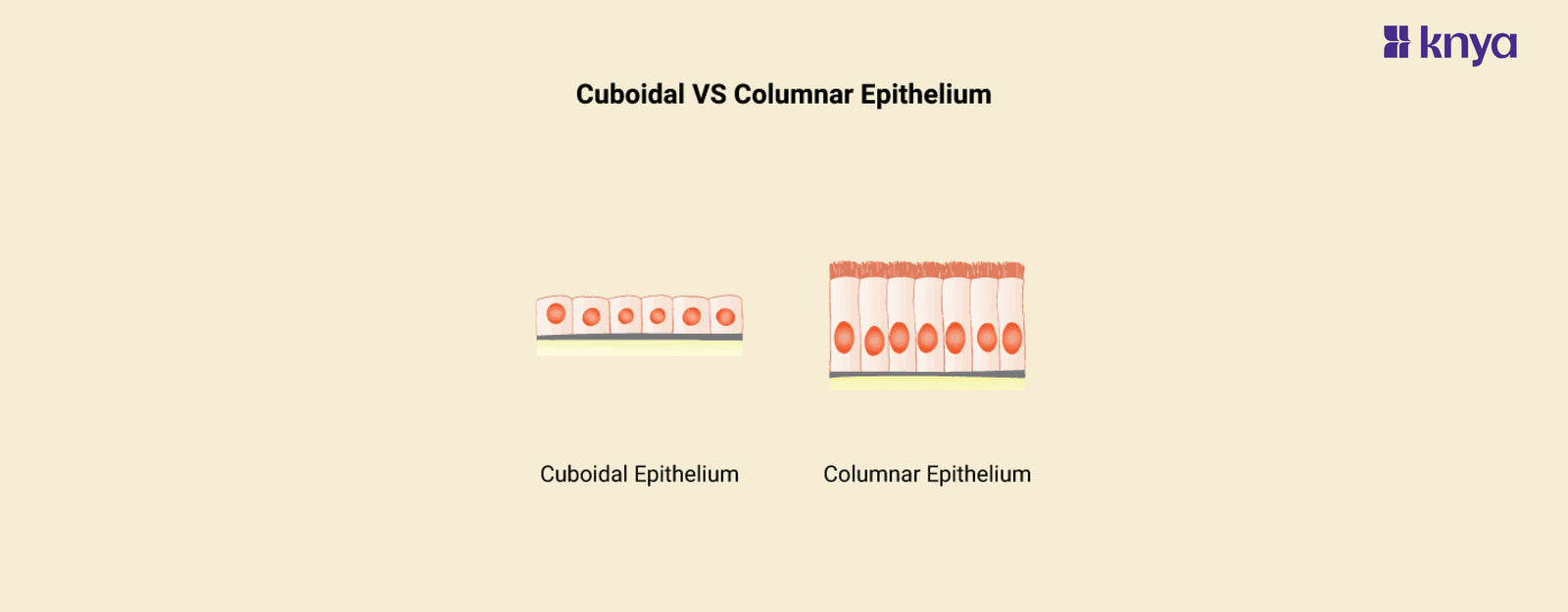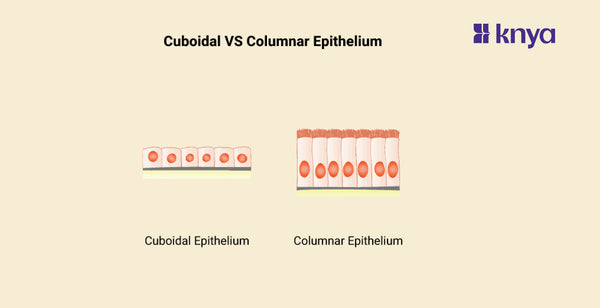Difference Between Cuboidal and Columnar Epithelium: The two basic forms of epithelial tissue are Cuboidal and Columnar Epithelium, which differ in cell shape. Cuboidal cells, which resemble cubes in shape, are frequently seen lining organs involved in secretion and absorption, such as kidney tubules and the surface of the ovaries. In contrast, columnar cells are taller than they are broad, giving them a column-like appearance. Because of its elongated structure, columnar epithelium excels in absorption, as in the intestines, and may also be specialised for defence, as in the stomach, where it secretes mucus. The variation in cell form between cuboidal and columnar epithelium reflects their distinct functions in lining numerous organs throughout the body.
Differences Between Cuboidal and Columnar Epithelium
Cuboidal and columnar epithelium are two types of epithelial tissues found in the human body. They are both composed of cells tightly packed together, forming a protective barrier or lining over various surfaces. Following are the differences between the two:
|
Feature |
Cuboidal Epithelium |
Columnar Epithelium |
|
Shape |
Cube-shaped cells |
Tall and rectangular cells |
|
Height |
Shorter |
Taller |
|
Nucleus position |
Round and centrally located |
Elongated and located towards the basal side |
|
Function |
Involved in secretion and absorption |
Primarily involved in secretion and protection |
|
Location |
Found in glands, kidney tubules, and ducts |
Lines digestive tract, respiratory tract, and reproductive organs |
|
Microvilli |
Usually absent |
Often present on the apical surface for increased surface area |
|
Organelles |
Fewer organelles involved in secretion and absorption |
More organelles involved in secretion and absorption |
|
Specializations |
May lack specialized cells |
May possess specialized cells such as goblet cells for mucus secretion |
|
Secretions |
Secretes substances such as hormones, enzymes, and ions |
Often secretes mucus or digestive enzymes |
|
Protection |
Provides limited protection against mechanical stress |
Provides a more robust protective barrier |
Order the Best Jogger Scrub from Here!
What is Cuboidal Epithelium?
Cuboidal epithelium is a form of epithelial tissue characterised by cube-shaped cells with about equal proportions (height, breadth, and depth). This tissue is located in locations where secretion and absorption take place, such as the kidney tubule lining and the ovarian surface.
Browse Best Scrubs Collection
Key Features of Cuboidal Epithelium:
- The star of the show! Cuboidal epithelial cells resemble small cubes with about identical height, breadth, and depth.
- Don't be deceived by their simplistic design. Cuboidal epithelium excels in two important areas: secretion and absorption. They frequently include specialised features such as glands for secretion or microvilli for improved absorption.
- Cuboidal epithelium is a versatile player that may be found in many different parts of the body. Look for them lining glandular ducts, kidney tubules, the ovarian surface, and portions of the eye and thyroid.
- Cuboidal epithelium can be simple (a single cell layer) or stratified. Simple cuboidal epithelium is more prevalent and specialises in secretion and absorption, but stratified cuboidal epithelium offers a bit more protection in select areas.
What is Columnar Epithelium?
Another form of epithelial tissue is columnar epithelium, which has cells that are taller than broad and resemble columns. This tissue is present in regions where absorption, secretion, and protection are critical roles. For example, columnar epithelium borders the intestines, where nutrients are absorbed, and the stomach, where the underlying tissue is protected from the harsh digestive fluids. Columnar epithelial cells may also feature cilia, which are small hair-like projections that aid in the movement of mucus or other fluids.
Explore All Women's Scrub
Key Features of Columnar Epithelium:
- As the name implies, columnar epithelial cells are taller than broad, like towering pillars. This extended design improves their functionality.
- Columnar epithelium, like cuboidal epithelium, excels at absorption and secretion. They frequently have brush borders with microvilli to enhance surface area, which improves their efficiency in various operations.
- Columnar epithelium covers several interior sites where absorption and secretion are critical. They can be found in the lining of the intestines (both small and big), the stomach, and some areas of the respiratory system.
- The columnar epithelium is classified into three types: simple (single layer), pseudostratified (layered appearance but just one layer), and stratified. Each version provides varying levels of protection or specialisation for certain purposes.
Shop Best Lab Coats from Here!
Similarities Between Cuboidal and Columnar Epithelium
- Cuboidal and columnar epithelium are involved in secretion and absorption.
- They may be found lining different organs and tissues throughout the body.
- Both forms of epithelium are made up of closely packed cells that form continuous sheets.
- Both forms show polarity, having different apical and basal surfaces.
- They're both connected to an underlying basement membrane.
The key difference between cuboidal and columnar epithelium lies in their cell shape. Cuboidal epithelial cells are cube-shaped, with roughly equal height and width, while columnar cells are taller than they are wide, resembling columns. This difference in shape reflects their specialized functions. Cuboidal epithelium, often found in glands and kidney tubules, is involved in functions like secretion and absorption, while the elongated columnar epithelium, lining the intestines and stomach, excels at absorption and may possess surface features like microvilli to maximize this function.
| Check out More Articles | |
| Difference Between Cartilage And Bone | |
| Difference Between Endocrine And Exocrine Glands | |
| Difference Between Cell Wall And Cell Membrane | |















